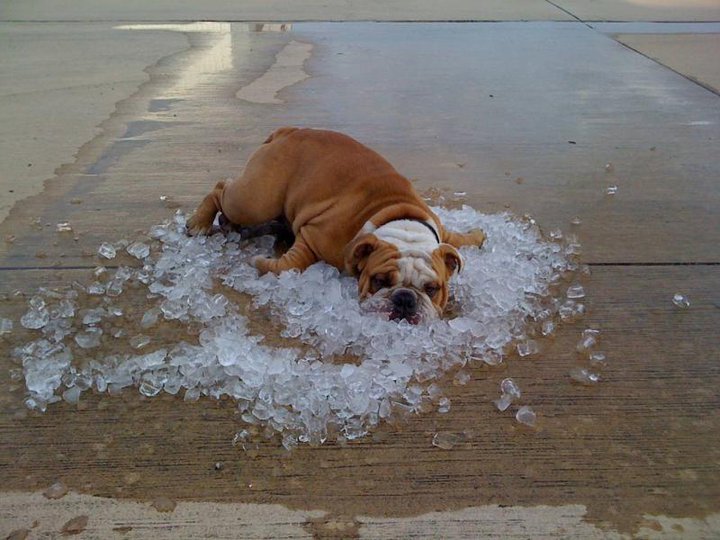 Welcome to the dog days of summer with what appears to be a bumper crop of “Excessive Heat Warnings” this year. In just this last week, I got to enjoy a nice balmy 105° in St Louis as I was heading home, Vermont hit 97°, and Norton Dam Kansas managed to take the title from Death Valley for one day with a 118° scorcher. While many bloggers, news agencies, & others put out some good advice & tips it was plainly obvious that some might have been in the sun for a little bit too long.
Welcome to the dog days of summer with what appears to be a bumper crop of “Excessive Heat Warnings” this year. In just this last week, I got to enjoy a nice balmy 105° in St Louis as I was heading home, Vermont hit 97°, and Norton Dam Kansas managed to take the title from Death Valley for one day with a 118° scorcher. While many bloggers, news agencies, & others put out some good advice & tips it was plainly obvious that some might have been in the sun for a little bit too long.
You’re Vehicle:
- Look for a shady spot to park – even if it means you have to walk another 50 feet
- If you can’t park in the shade or it won’t be in the shade later – crack open a window to allow heat to escape
- REMEMBER – AT NO TIME should you leave a child or pet in your car even if it will be “just for a minute” (yes it will be too hot for them even with a window or two rolled down)
- Sun shades do work somewhat – the main reason to use one on newer cars is so that you can grab hold of your steering wheel without burning your hands. No sun shade? No problem – just throw a towel or something similar over the wheel
- To get in to a superhot vehicle without frying or standing in the sun for too long – roll down the windows partway & open & close a door a few times.
- Make sure if you have a GPS, laptop, CD’s, I-Pad, a copier or anything similar it is covered &/or placed in a shady area of the car (Trunk, Floor Board, Glove Compartment)
You’re Body:
- Try to plan your activities so you are not out during the hottest parts of the day
- Wearing a hat with light weight, light colored & loose-fitting clothing that covers all the skin is best. Not only does this prevent sun burn but it also cuts down on how much heat you must shed (solar loading doesn’t only apply to buildings, steering wheels, or vehicles folks)
- Make sure you stay hydrated – as the saying goes, if you are getting thirsty it’s too late… (try to stay away from sugary or caffeinated drinks & no, water isn’t enough in some cases – see working safely article)
- For more information we recommend you check out our articles on;
- Heat stress – this article was designed mainly for those working in the heat & covers the signs, ways of avoiding it, & how to treat it
- The Sun & You – this article mainly revolves around those on vacation, & deals primarily with the prevention & treatment of sun burns
- Working safely in the heat – this article is pretty well a broad ranging article dealing with fluids, eating properly, do salt tablets work, bringing shade & wind with you, etc…
Cooking & Cleaning:
Wasted or used energy (electricity, gas, etc…) has one major by-product which is heat, so the less you use the less heat is dumped into the house which needs to be removed
- Consider cooking with your microwave, outdoor grill, or simply enjoying a nice salad. This will help cut down on the amount of heat introduced into the house
- Use the delay timer on your clothes washer and dishwasher so they run during the night
- Make sure your water heater is set no higher than 120° & any recirculating pumps are either use activated or turned off
Lights & Appliances:
- Turn off lights, and other devices not in use. Below is a picture of a bathroom light bar, an X-Box, a Blu-Ray player & a Cable Box that have just been left on & paused – e.g. their lowest power setting without being turned off.
- Change out incandescent bulbs with more efficient CFL or LED bulbs. Be warned even CFL’s give off heat as also shown below, so if you don’t need them it is better to turn them off also.
- For more money saving energy efficiency & conservation ideas you may also want to check out our 25 conservation tips & associated articles
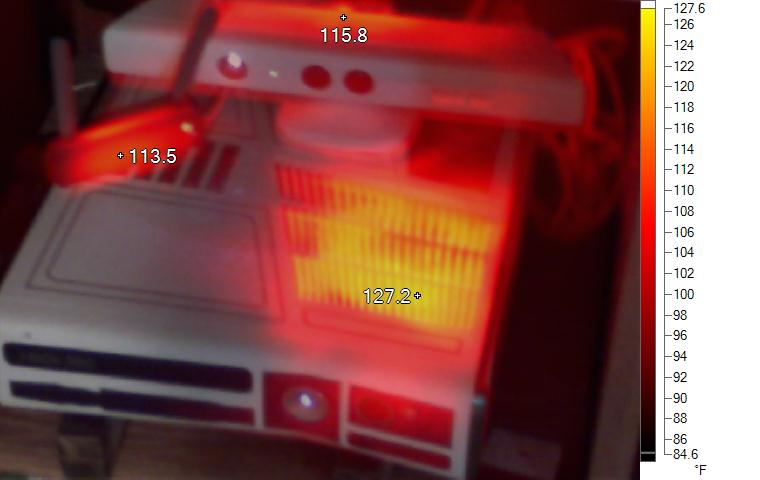
XBox with Kinect & wireless adapter in Infrared
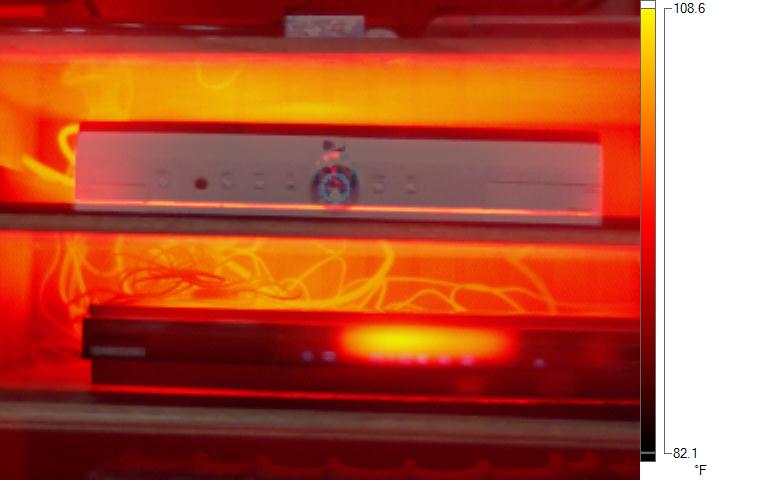
BluRay Player & DVR in Infrared – pretty interesting seeing the layers of heat
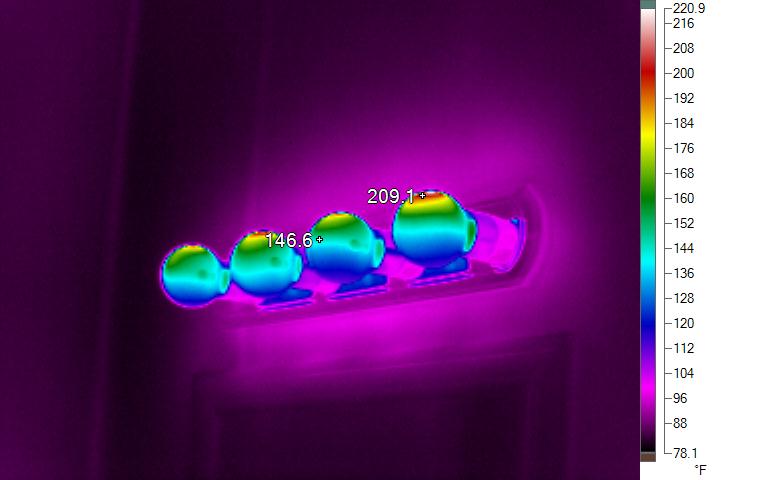
4-40 watt Incandescent lights in a bathroom light bar
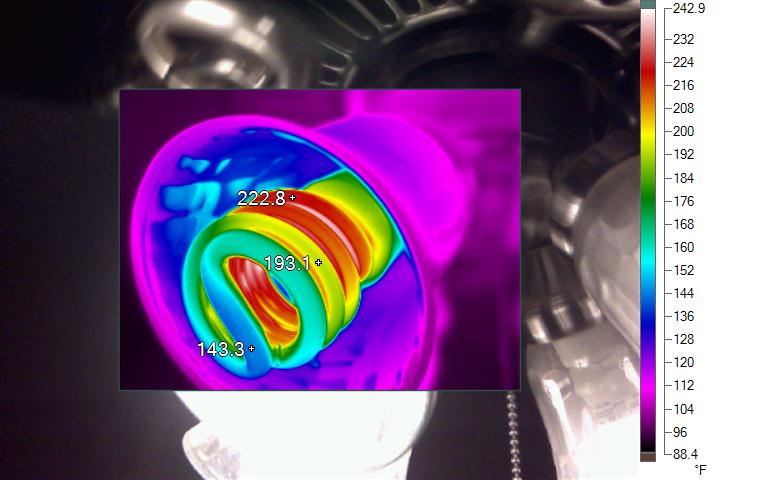
But wait, that’s hotter than the incandescent bulbs… ahhh someone needs to attend Infrared class. With that said this also happens to not only be an older style ballast but the wrong type to be used with a ceiling fan (this one is actually designed for floor lamps)
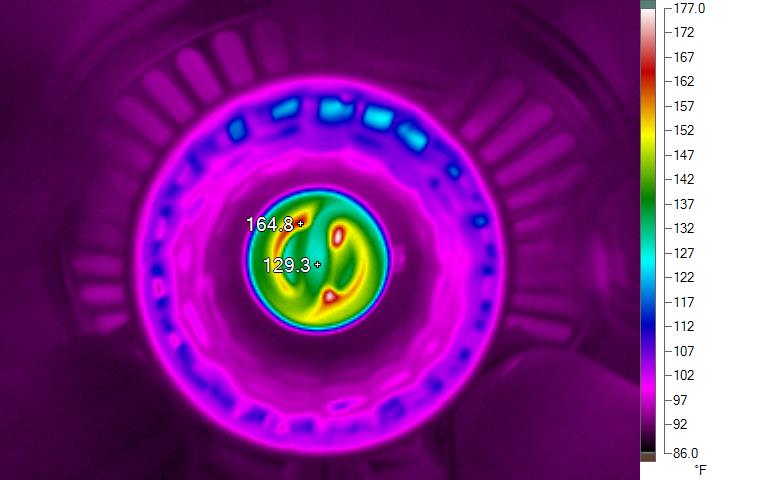
Slightly smaller sized bulb with the same lumens as above
Cooling Equipment:
An Air Conditioning unit removes two types of heat; latent & sensible. Sensible heat is basically the temperature you see on a thermometer. Latent heat is hidden heat or essentially the removal of the excess “humidity” in the air. Controlling the amount of moisture is the key to being comfortable or why it might feel cool at 80 degrees one day & yet so hot at 80 degrees the next.
- Consider opening your windows at night is at or below an acceptable level AND the dew point is 50 or lower
- If that isn’t an option, turn the AC down at night (say from 78 or 80 to 75 or 76) as this will not only help you sleep better, remove more moisture, but also help cool the place off for the next day. (If you have a time of use plan you win even more)
- If you live in a “dry-heat” area consider utilizing a “swamp” or evaporative cooler – not only will this save you a serious chunk of change on your AC bill but will help prevent you & other items from drying out. Unfortunately, though as soon as the dew point hits 45 or above the “comfortable feeling” will disappear quickly & you will need to flip the cover & switch over to AC.
- Ceiling fans & portable fans are great for spot cooling / moving the air around. There have been numerous studies where people have felt just as comfortable (if not more) when utilizing them even with the AC set a few degrees higher. The catch is it only applies & works if someone is in the room so turn them off when leaving the room
- While moving air is great, leave the AC fan on “Auto” – If you leave the fan on you are simply reintroducing that that water that didn’t flow out through the condensate line back into the air.
- Check your air filter regularly & stay up on your homes maintenance
Exterior shading:
- If you have minimal overhangs or trees, consider installing some awnings, shades or exterior shutters that will block the direct sun during the summer but allow for it to come in during the winter. As an FYI, if you live in areas prone to hurricanes, tornados or high winds I would advise you to stay clear of large overhangs (anything over 16”) assuming you could even get it past the code officials.
- Storm doors & windows are great when it is cold out, but during the summer one needs to swap those out with screens. If you have a particularly sunny window or bank of windows, it might be wise to check out “solar screens”
- While one would love to have a large tree shading their home, that isn’t always possible which allows for a ton of solar heat to push into the house. While radiant barriers do work in some climates, the best option for all climates is to go with an ENERGY STAR® roof covering which helps block the heat from even getting in
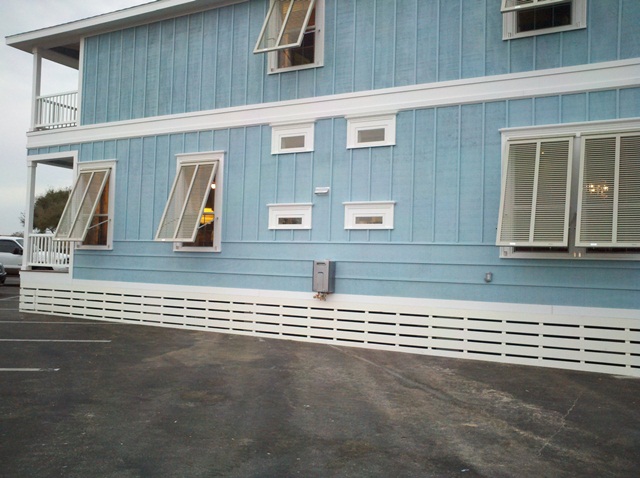

Great check list, Sean. Any article that uses IR to analyze heat sources and energy loss is great, in my book! BTW, you mentioned CFLs giving off more heat than one would at first think. One of the things that perplexes me is why low wattage LED bulbs also cast so much heat off via their cooling fins. I recall measuring one back in the winter, and if I recall correctly, the surface of the fins were about 150 degrees F. I can’t imagine why something that consumes so little energy (comparatively speaking) still seems to waste much of it in the form of excess heat. Any comments on this?
Thanks again for the great checklist
~John
Sorry John for some reason I didn’t get a notification and just saw this. In short I would say it is because of the transformer / converter is required to change the power state to power the bulb. In a perfect world we wouldn’t be using AC for fluorescents or LEDS & instead we would be using DC. The issue is similar with the fluorescents and the ballasts
My pleasure & thanks for the great question & comments
One other excellent idea we use all the time in our office during hot days (of which there are many here in North Carolina) is to keep the blinds closed at all times except in the early morning hours when we just get in. Not sure if the cooling effect is mostly psychological or not but it sure seems to help.
In some cases it can be psychological as mentioned, but in many cases (especially with commercial structures) it does help reflect the radiant heat back out. If you don’t have tinting installed it might be worth checking out
Some great tips to keep your cool
Appreciate your site and how you explain issues as I like to know the “why” and not just the bottom line. Your explanation of the directionality of ceiling fans gave me the info I needed…and I followed the trail to managing energy and comfort during the summer, checking out several of your links. I also plan to show the guys in the house the IR for our electronic equipment. Thanks!
One thing on which I am confused: the bulb which is labeled “incandescent” looks like some of my florescents. And (to enhance the credibility of this site, not to be knit-picky) “You’re” – which is the same as “you are” above more correctly should be “Your”.
Thank you very much for the kind words & glad it was beneficial. As for the incandescent – that is actually referring to the missing picture above it (I guess not everything transferred over when I moved the site). Hopefully after I get back from the SkillsUSA championships at the end of this week, I will remember to fix that and probably one of a hundred grammatical errors. For the Infrared piece are you talking about the one for setting up a predictive infrared plan for your business? Once again thanks again
I have a more mundane goal with the infrared images you posted showing the heat output of electronic equipment, thus illustrating the benefits of such items being turned off promptly. It’s easy to loose energy in the”little” things which prove to not be little in aggregate. (Like me remembering to turn off the fan when leaving the kitchen!)
English professor I am not – but I do work on it 🙂
Many thanks & glad it was helpful
Credibility ruined by wrong use of “you’re.”
Just kidding, still a great article, but I did not expect it to be, given the title.
LOL – thanks & the issue has been fixed. Whew, credibility restored 🙂
Great check list, Sean. Any article that uses IR to analyze heat sources and energy loss is great, in my book! BTW, you mentioned CFLs giving off more heat than one would at first think. One of the things that perplexes me is why low wattage LED bulbs also cast so much heat off via their cooling fins. I recall measuring one back in the winter, and if I recall correctly, the surface of the fins were about 150 degrees F. I can’t imagine why something that consumes so little energy (comparatively speaking) still seems to waste much of it in the form of excess heat. Any comments on this?
Thanks again for the great checklist
~John
Sorry John for some reason I didn’t get a notification and just saw this. In short I would say it is because of the transformer / converter is required to change the power state to power the bulb. In a perfect world we wouldn’t be using AC for fluorescents or LEDS & instead we would be using DC. The issue is similar with the fluorescents and the ballasts
My pleasure & thanks for the great question & comments
One other excellent idea we use all the time in our office during hot days (of which there are many here in North Carolina) is to keep the blinds closed at all times except in the early morning hours when we just get in. Not sure if the cooling effect is mostly psychological or not but it sure seems to help.
In some cases it can be psychological as mentioned, but in many cases (especially with commercial structures) it does help reflect the radiant heat back out. If you don’t have tinting installed it might be worth checking out